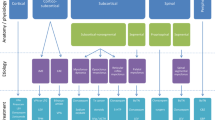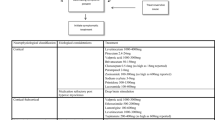Opinion statement
The diagnosis and treatment of myoclonus pose a particular challenge to the neurologist. Few well-controlled double-blind studies of antimyoclonic agents have been performed, and clinical rating of the effectiveness of treatment has been primarily descriptive. As a result, therapy is often empiric. This article reviews the author’s approach to treating patients with myoclonus. Three principles guide treatment. First, the cause and physiology of the myoclonic jerks must be ascertained before choosing the appropriate therapy. Second, multiple drugs often must be used in combination to achieve functional improvement. Third, given the paucity of adequately controlled trials, the treating physician must rely on well-documented case series of patients with myoclonic syndromes who obtained benefit from a drug.
Similar content being viewed by others
References and Recommended Reading
Marsden CD, Hallett M, Fahn S: The nosology and pathophysiology of myoclonus. In Movement Disorders. Edited by Marsden CD, Fahn S. London: Butterworth Scientific; 1982:196–248.
Fahn S, Marsden CD, Van Woert MH: Definition and classification of myoclonus. In Advances in Neurology, vol 43. Edited by Fahn S. New York: Raven Press; 1986:1–5.
Pappert EJ, Goetz CG: Treatment of myoclonus. In Treatment of Movement Disorders. Edited by Kurlan R. Philadelphia: J.B. Lippincott Co.; 1995:247–336. With 687 references, this chapter is the most comprehensive review of the treatment of myoclonus.
Shibasaki H: Overview and classification of myoclonus. Clin Neurosci 1996, 3:189–192.
Physicians’ Desk Reference. New Jersey: Medical Economics Company; 1998:428–434, 2475–2478.
Personal communication.
Brown P, Steiger MJ, Thompson PD, et al.: Effectiveness of piracetam in cortical myoclonus. Mov Disord 1993, 8:63–68.
Ikeda A, Shibasaki H, Tashiro K, et al. and the Myoclonus/ Piracetam Study Group: Clinical trial of piracetam in patients with myoclonus: nationwide multi-institution study in Japan. Mov Disord 1996, 11:691–700.
Obeso JA, Artieda J, Luquin MR, et al.: Antimyoclonic action of piracetam. Clin Neuropharmacol 1986, 9:58–64.
Obeso JA, Artieda J, Quinn N, et al.: Piracetam in the treatment of different types of myoclonus. Clin Neuropharmacol 1988, 11:529–536.
Koskiniemi M, Van Vleyemen B, Hakamies L, et al.: Piracetam relieves symptoms in progressive myoclonus epilepsy: a multicenter, randomized, double blind, crossover study comparing the efficacy and safety of three dosages of oral piracetam with placebo. J Neurol Neurosurg Psychiatry 1998, 64:344–348. A well-designed study showing that piracetam is an effective treatment for progressive myoclonic epilepsy.
Thal LJ, Sharpless NS, Wolfson L, Katzman R: Treatment of myoclonus with L-5-hydroxytryptophan and carbidopa: clinical, electrophysiological, and biochemical observations. Ann Neurol 1980, 7:570–576.
Sternberg EM, Van Woert MH, Young SN, et al.: Development of a scleroderma-like illness during therapy with L-5-hydroxytryptophan and carbidopa. N Engl J Med 1980, 303:782–787.
Nightingale SL: From the Food and Drug Administration. JAMA 1992, 14:1828.
Pranzatelli MT, Tate E, Huang Y, et al.: Neuropharmacology of progressive myoclonic epilepsy: response to 5-hydroxy-L-tryptophan. Epilepsia 1995, 36:783–791.
Lance JW, Adams RD: The syndrome of intention or action myoclonus as a sequel to hypoxic encephalopathy. Brain 1963, 86:111–136.
Fahn S: Posthypoxic action myoclonus: review of the literature and report of two new cases with response to valproate and estrogen. In Advances in Neurology, vol 26. Edited by Fahn S. New York: Raven Press; 1979:49–84.
Fahn S: Posthypoxic action myoclonus: literature review update. In Advances in Neurology, vol 43. Edited by Fahn S. New York: Raven Press; 1986:157–169.
Frucht S, Fahn S: The clinical spectrum of posthypoxic myoclonus. Mov Disord 2000, in press.
Iivanainen M, Himberg J: Valproate and clonazepam in the treatment of severe progressive myoclonus epilepsy. Arch Neurol 1982, 39:236–238.
Vaamonde J, Legarda I, Jimenez-Jimenez J, Obeso JA: Acetazolamide improves action myoclonus in Ramsay Hunt syndrome. Clin Neuropharmacol 1992, 15:392–396.
Quinn NP: Essential myoclonus and myoclonic dystonia. Mov Disord 1996, 11:119–124.
Lundemo G, Persson HE: Hereditary essential myoclonus. Acta Neurol Scand 1985, 72:176–179.
Fahn S, Sjaastad O: Hereditary essential myoclonus in a large Norwegian family. Mov Disord 1991, 6:237–247.
Duvoisin R: Essential myoclonus: response to anticholinergic therapy. Clin Neuropharmacol 1984, 7:141–147.
Ives TJ, Fleming MF, Weart CW, Bloch D: Treatment of intractable hiccups with intramuscular haloperidol. Am J Psychiatry 1985, 142:1368–1369.
Stalnikowicz R, Fich A, Troudart T: Amitriptyline for intractable hiccups. N Engl J Med 1986, 315:64–65.
Jacobson PL, Messenheimer JA, Farmer TW: Treatment of intractable hiccups with valproic acid. Neurology 1981, 31:1458–1460.
Ramirez FC, Graham DY: Treatment of intractable hiccup with baclofen: results of a double-blind randomized, controlled, cross-over study. Am J Gastroenterol 1992, 87:1789–1791.
Burke AM, White AB, Brill N: Baclofen for intractable hiccups [letter]. N Engl J Med 1988, 319:1354.
Deuschl G, Mischke G, Schenck E, et al.: Symptomatic and essential rhythmic palatal myoclonus. Brain 1990, 113:1645–1672. The classic paper defining the natural history of palatal myoclonus.
Ferro JM, Castro-Caldas A: Palatal myoclonus and carbamazepine. Ann Neurol 1981, 10:402.
Jabbari B, Rosenberg M, Scherokman B, et al.: Effectiveness of trihexyphenidyl against pendular nystagmus and palatal myoclonus: evidence of cholinergic dysfunction. Mov Disord 1987, 2:93–98.
Cakmor R, Idiman E, Idiman F, et al.: Essential palatal tremor successfully treated with flunarizine. Eur Neurol 1977, 38:133–134.
Scott B, Evans RW, Jankovic J: Treatment of palatal myoclonus with sumatriptan. Mov Disord 1996, 11:748–751.
Varney SM, Demetroulakos JL, Fletcher MH, et al.: Palatal myoclonus: treatment with Clostridium botulinum toxin injection. Otolaryngol Head Neck Surg 1996, 114:317–320.
Bryce GE, Morrison MD: Botulinum toxin treatment of essential palatal myoclonus tinnitus. J Otol 1998, 27:213–216.
Averbuch-Heller L, Remler B: Opsoclonus. Semin Neurol 1996, 16:21–26.
Nitschke M, Hochberg F, Dropcho E: Improvement of paraneoplastic opsoclonus-myoclonus after protein A column therapy [letter]. N Engl J Med 1995, 332:192.
Brown P, Thompson PD, Rothwell JC, et al.: Axial myoclonus of propriospinal origin. Brain 1991, 144:197–214.
Jankovic J, Pardo R: Segmental myoclonus: clinical and pathologic study. Arch Neurol 1986, 43:1025–1031.
Jankovic J, Beach J: Long-term effects of tetrabenazine in hyperkinetic movement disorders. Neurology 1997, 48:358–362.
Jimenez-Jimenez FJ, Roldan A, Zancada F, et al.: Spinal myoclonus: successful treatment with the combination of sodium valproate and L-5-hydroxytryptophan. Clin Neuropharmacol 1991, 14:186–190.
Polo KB, Jabbari B: Effectiveness of botulinum toxin type A against painful limb myoclonus of spinal cord origin. Mov Disord 1994, 9:233–235.
Lagueny A, Tison F, Burbaud P, et al.: Stimulussensitive spinal segmental myoclonus improved with injections of botulinum toxin type A. Mov Disord 1999, 14:182–185.
Brown P, Rothwell JC, Thompson PD, Marsden CD: Propriospinal myoclonus: evidence for spinal “pattern” generators in humans. Mov Disord 1994, 9:571–576.
Chokroverty S, Walters A, Zimmerman T, Picone M: Propriospinal myoclonus: a neurophysiologic analysis. Neurology 1992, 42:1591–1595.
Krueger BR: Restless legs syndrome and periodic movements of sleep. Mayo Clin Proc 1990, 65:999–1006.
Staedt J, Stoppe G, Kogler A, et al.: Nocturnal myoclonus syndrome (periodic movements in sleep) related to central dopamine D2-receptor alteration. Eur Arch Psychiatry Clin Neurosci 1995, 245:8–10.
Ohanna N, Peled R, Rubin A, et al.: Periodic leg movements in sleep: effect of clonazepam treatment. Neurology 1985, 35:408–411.
Mitler MM, Browman CP, Menn SJ, et al.: Nocturnal myoclonus: treatment efficacy of clonazepam and temazepam. Sleep 1986, 9:385–392.
Hening W, Walter A, Cote L, Fahn S: Opiate responsive myoclonus [abstract]. Ann Neurol 1983, 14:112.
Akpinar S: Treatment of restless leg syndrome with levodopa plus benserazide [letter]. Arch Neurol 1982, 39:739.
Montplaisir J, Godbout R, Poirier G, Bedard MA: Restless legs syndrome and periodic movements in sleep: pathophysiology and treatment with L-dopa. Clin Neuropharmacol 1986, 9:456–463.
Brodeur C, Montplaiser J, Godbout R, Marinier R: Treatment of restless legs syndrome and periodic movements during sleep with L-dopa: a double-blind, controlled study. Neurology 1988, 38:1845–1848.
Trenkwalder C, Stiasny K, Pollmacher T, et al.: L-Dopa therapy of uremic and idopathic restless legs syndrome: a double-blind, crossover trial. Sleep 1995, 18:681–688.
Walters AS, Hening WA, Kavey N, et al.: A double blind randomized crossover trial of bromocriptine and placebo in restless legs syndrome. Ann Neurol 1988, 24:455–458.
Staedt J, Wassmuth F, Ziemann U, et al.: Pergolide: treatment of choice in restless leg syndrome (RLS) and nocturnal myoclonus syndrome (NMS). A double-blind randomized crossover trial of pergolide versus L-dopa. J Neural Transm 1997, 104:461–468. An important study that suggests that dopamine agonists should be used first in the treatment of restless leg syndrome.
Author information
Authors and Affiliations
Rights and permissions
About this article
Cite this article
Frucht, S. Myoclonus. Curr Treat Options Neurol 2, 231–241 (2000). https://doi.org/10.1007/s11940-000-0006-1
Issue Date:
DOI: https://doi.org/10.1007/s11940-000-0006-1




